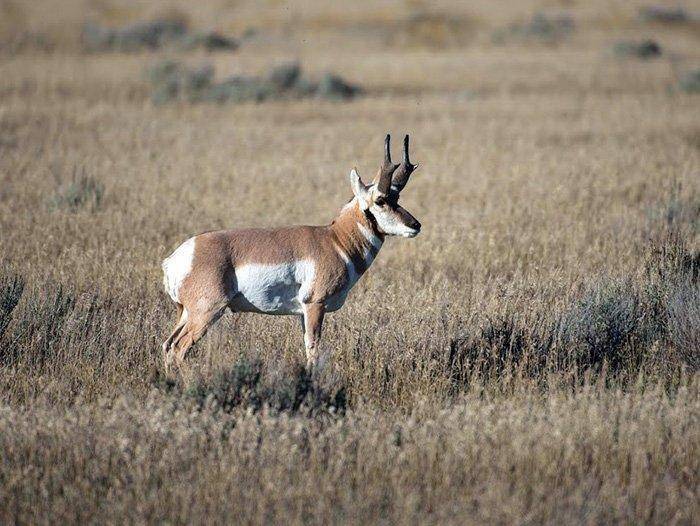DWR Press Release
SALT LAKE CITY — Depending on which unit you applied for, you might have a better chance at drawing a permit to hunt big game in Utah this fall.
At their meeting on April 26, members of the Utah Wildlife Board — a panel of seven citizens appointed by the governor — approved permit numbers for this fall’s hunts. Buck deer, buck pronghorn, bull moose and Rocky Mountain bighorn sheep are among the animals for which more permits will be available.
Covy Jones, big game coordinator for the Division of Wildlife Resources, says most of the state’s big game species are doing well. He credits much of the success to implementation of species management plans that are drafted by DWR biologists and members of the public and approved by the Utah Wildlife Board. “If you enjoy hunting or viewing big game,” Jones says, “it’s a great time to live in Utah.”
Starting May 5, the permit numbers for each of the state’s hunting units should be available at wildlife.utah.gov/public_meetings.
Utah’s big game drawing will be held in May. If you applied for a permit earlier this year, you should know by May 30 if you drew one.
Permit numbers
The following is the total number of big game permits offered in Utah in 2017 and the number the Wildlife Board approved for 2018:
| Hunt | 2017 | 2018 |
|---|---|---|
| General buck deer | 89,050 | 90,650 |
| Premium limited-entry deer | 184 | 184 |
| Management buck deer (including ‘cactus’ bucks) | 61 | 71 |
| Limited-entry deer | 1,191 | 1,133 |
| Doe deer | 1,470 | 1,955 |
| General any bull elk | 15,000 | 15,000 |
| Youth any bull elk | 500 | 500 |
| General spike bull elk | 15,000 | 15,000 |
| Limited-entry bull elk | 2,833 | 2,876 |
| Cow elk, public draw | 9,830 | 10,090 |
| Cow elk, private lands only | 8,790 | 9,105 |
| Buck pronghorn | 849 | 883 |
| Doe pronghorn | 750 | 610 |
| Bull moose | 68 | 84 |
| Cow moose | 22 | 34 |
| Bison | 148 | 152 |
| Bison (archery only) | 10 | 15 |
| Desert bighorn sheep | 53 | 56 |
| Rocky Mountain bighorn sheep | 32 | 39 |
| Mountain goat | 106 | 117 |
| Mountain goat (archery only) | 2 | 4 |
Big game animals doing well
While all of Utah’s big game species are doing well, Jones is especially excited about deer, pronghorn and bighorn sheep:
General buck deer
After the deer hunts are over each fall, DWR biologists go afield and classify the number of bucks, does and fawns on each unit. On 11 of Utah’s 29 general season units, biologists want to see 15 to 17 bucks per 100 does. On the remaining 18 units, the objective is 18 to 20 bucks per 100 does.
Based on the number of bucks observed after last fall’s hunts, board members approved a recommendation to increase permits on 10 units. On six units, fewer permits will be offered. On 13 units, permit numbers will stay the same as 2017.
The general rifle hunt has been split into two hunts — an early hunt in September and a later hunt in October — on most of the units where permits were increased for 2018.
“Permits on these units will be split between two hunts,” Jones says. “Splitting the permits between two hunts should help reduce hunter crowding and hopefully allow everyone to have a good experience.”
Buck pronghorn
A new management plan for pronghorn means more hunters will have a chance to hunt buck pronghorn in Utah this fall.
Data collected in Utah and other states suggest two things about buck pronghorn. First, survival rates for bucks — even if no animals are taken by hunters — is relatively low: one out of every five bucks typically dies each year from a variety of causes other than hunting. Second, a buck pronghorn’s horns don’t grow much after the animal reaches two years of age.
“Because of these lower survival rates,” Jones says, “and because most of their horn growth occurs by two years of age, it doesn’t make sense to manage for older pronghorn.”
Utah’s pronghorn management plan was revised in fall 2017. “The plan directs us to manage the population so the average age of pronghorn taken by hunters is between two and three years of age,” he says.
In past years, most pronghorn taken by hunters in Utah were almost four years old.
“Because we’re now managing for younger animals,” Jones says, “we can offer more hunting opportunities this fall while still providing a quality opportunity for hunters.”
Bighorn sheep
In the case of Rocky Mountain bighorns, a new population on the Oak Creek Mountains has increased to the point that hunters can take a few rams. “And the population on the Newfoundland Mountains is doing really well,” Jones says. “We’re excited that more Rocky Mountain and desert bighorn sheep opportunities will be available in Utah this fall.”

